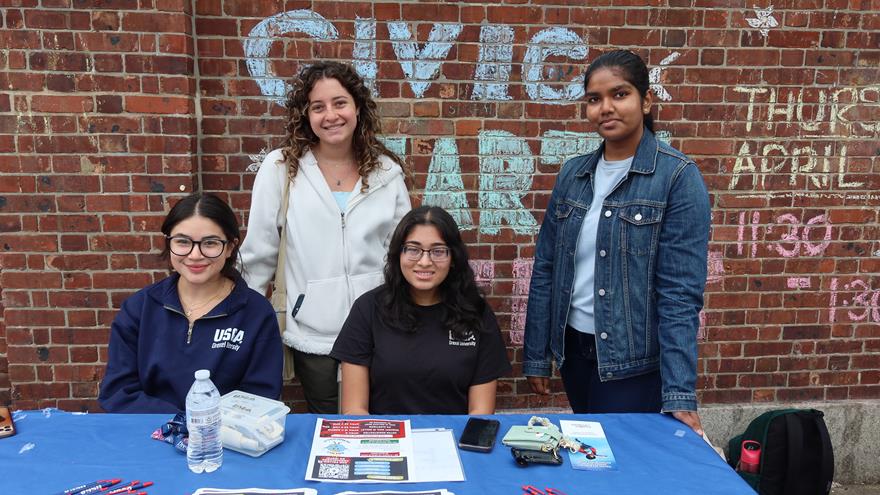It’s a Whole New Ballgame for Commencement 2016

Organizing a single commencement ceremony for a university the size of Drexel is an epic undertaking. Doing it in a baseball stadium like Citizens Bank Park only adds to the impressive scope. Planners from Drexel and the Philadelphia Phillies have been working hard to make certain that when Commencement happens on June 11, every detail is worthy of the size of the university it celebrates.
Take the procession, for example. The field at Citizens Bank Park is large enough that each of the 3,000 expected graduates would have more than enough time to enjoy the moment. But how do you get the graduates from the field into the stands for the rest of the ceremony? The stadium was not designed for easy access between the field and the seats.
“If we’re processing into the field, these seats aren’t easy to get to,” said Salvatore DeAngelis, director of security for the Philadelphia Phillies, as he traced a line on a printout of the park from the single entrance to the bleachers across the field.
Temporary stairs above the dugouts are suggested, as is staggering the procession. But that brings up another important element: equal time in the procession for all involved.
“The worry is, these grads get seen all the way around,” said Jackie Hopkins, director of event and visitor relations for the Office of Enrollment Management & Student Success. She marked the twin paths of the imaginary graduates with a blue ballpoint pen: one group goes all the way around the outfield, while the other does a sharp turn and enters the bleachers. “These grads just walk in and sit.”
“We’ll have two video boards by then,” DeAngelis said. The ceremony will be shown on the Phillies’ giant “PhanaVision II” screens. “We’re having another one installed this week on this side.”
“That solves a lot of problems,” said Casey Turner, PhD, assistant vice president in Student Life at Drexel.
The path to this meeting started with a conversation between Turner and Subir Sahu, PhD, associate vice president and dean of Student Life, during Welcome Week. Sahu was charged by the community energy from Welcome Week, and the success of turning move-in, which in the past was split over several days, into a single day where all the students arrived on campus together.
“You could not help but get a feel for that excitement, that spirit, that energy in the campus community,” Sahu said. “So when you look at things like move-in and Welcome Week and the successes of that, naturally, the quintessential crowning event for everyone is Commencement.”
In previous years, Commencement was staggered, because no one campus venue was big enough to hold the entire University. Each school or college would have its own ceremony in the Daskalakis Athletic Center (DAC), separate from the other entities on campus. But even that pushed the DAC to its limits, greatly limiting the number of tickets each graduate could purchase. Now, all of Drexel will be able to come together.
“This is a movement toward the ‘One University’ concept President Fry talks about a great deal,” Turner said.
But that doesn’t mean each school and college within Drexel won’t have its own place to recognize their graduates. Two days before the University’s Commencement on June 11, the individual college and school ceremonies will be held, to allow each their own variation of pomp and circumstance. Sahu and Turner have worked with and consulted over 100 students, staff and faculty from all over the University, in order to make Commencement happen.
When considering locations, Citizen’s Bank Park quickly became the organizer’s top choice, and the Phillies’ willingness to host the event — the team is playing away games that week — meant that the decision was made astonishingly quickly.
The Phillies, for their part, are proving to be an ideal partner for this event. The stadium was designed with the help of an Americans with Disabilities Act consultant, with multiple elevators, companion seating and wheelchair-accessible restrooms and concessions. The concessions will be available during Commencement, allowing the hungry to sneak off and go get a bite after the ceremony.
With the procession solved, the organizers are now tackling parking, tickets, metal detectors, signage, rain plans and a host of other Drexel-specific issues.
“Somebody just yesterday mentioned, ‘Every college has a flag.’ What do you mean, every college has a flag? Where are the flags? Does anybody know who has them?” Turner said. Thankfully, they were able to find who has the flags.
For Sahu, the intense planning is worth it. “For a kid who grew up crying when his sports team didn’t win, it was just amazing to walk through the stadium, and through all these places and be on the field. I’ve had students who have come to me and said ‘I’ve had season tickets to the Phillies my entire life. And now to be in the stadium…’ It’s just magical.”
It is magical to be on that field, to look out into the stands instead of being seated in them. There’s electricity on that field, an energy that speaks to momentous events. Triumphs were made upon that grass. Hopes were dashed. Lives were changed. And in June, 3,000 or so graduated students will walk across that field, closing one chapter of their lives and beginning a new one. In that context, holding Commencement anywhere else seems unthinkable.
This article first appeared in the spring issue of Drexel Quarterly, published in April 2016.In This Article
Drexel News is produced by
University Marketing and Communications.

